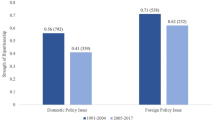Abstract
During the last 50 years, political polarization in the US House of Representatives has intensified. One explanation for this trend emphasizes the importance of congressional redistricting. This paper analyzes the relationship between political polarization and redistricting in the context of two trade liberalization bills. The results of the paper indicate that redistricting has not contributed significantly to party polarization over trade policy although it has produced a partisan shift in favor of trade liberalization. Redistricting does not appear to impact political polarization largely because district-level characteristics currently are dominated by broader, national factors such as party affiliation. The results of the paper clearly demonstrate this point by showing that changes in party affiliation have a much greater impact on voting behavior than changes in district characteristics. The paper also finds, however, that institutional control of the redistricting process at the state level has influenced political polarization with respect to trade policy.








Similar content being viewed by others
Notes
Because Texas enacted a new and extensive redistricting plan in 2003, the number of continuous districts used here is 392, as opposed to 407 in Carson et al. (2007). Their sample ran through 2002 and consequently excluded the 2003 Texas redistricting plan.
The nine states that employed redistricting commissions in the aftermath of the 2000 census were Arizona, Connecticut, Idaho, Indiana, Iowa, Maine, Montana, New Jersey, and Washington.
References
Ansolabehere, S., Snyder, J. M., & Stewart, C. (2001). Candidate positioning in US House elections. American Journal of Political Science, 45(1), 136–159.
Barone, M., & Cohen, R. (2005). The almanac of American politics 2006. Washington: National Journal.
Carson, J. L., Crespin, M. H., Finocchiaro, C. J., & Rohde, D. W. (2007). Redistricting and party polarization in the US House of Representatives. American Politics Research, 35(6), 878–904.
Destler, I. M. (2005). American trade politics. Washington: Institute for International Economics.
Downs, A. (1957). An economic theory of democracy. New York: Harper & Row.
Forgette, R., & Platt, G. (2005). Redistricting principles and incumbency protection in the US Congress. Political Geography, 24(8), 934–951.
Glazer, A., & Robbins, M. (1985). Congressional responsiveness to constituency change. American Journal of Political Science, 29(2), 259–273.
Jacobson, G. C. (1999). Reversal of fortune: the transformation of US House elections in the 1990s. In D. Brady, J. Cogan, & M. Fiorina (Eds.), Continuity and change in House elections (pp. 10–38). Stanford: Stanford University Press.
Jacobson, G. C. (2006). Why other sources of polarization matter more. In P. S. Nivola & D. W. Brady (Eds.), Red and blue nation? Characteristics and causes of America’s polarized politics (pp. 284–290). Washington: Brookings Institution Press.
Congressional Quarterly (1990). Jigsaw politics. Washington: Congressional Quarterly.
Jones, D. R., & McDermott, M. L. (2011). The salience of the Democratic Congress and the 2010 elections. PS: Political Science and Politics, 442(2), 297–301.
Mann, T. E. (2006). Polarizing the House of Representatives: how much does gerrymandering matter. In P. S. Nivola & D. W. Brady (Eds.), Red and blue nation? Characteristics and causes of America’s polarized politics (pp. 263–283). Washington: Brookings Institution Press.
McCarty, N., Poole, K. T., & Rosenthal, H. (2009). Does gerrymandering cause polarization? American Journal of Political Science, 53(3), 666–680.
McCarty, N., Poole, K. T., & Rosenthal, H. (2006). Polarized America: the dance of ideology and unequal riches. Cambridge: MIT Press.
Mutz, D. C. (2006). How the mass media divide us. In P. S. Nivola & D. W. Brady (Eds.), Red and blue nation? Characteristics and causes of America’s polarized politics (pp. 223–248). Washington: Brookings Institution Press.
Nivola, P. S., & Brady, D. W. (2006). Red and blue nation? Characteristics and causes of America’s polarized politics. Washington: Brookings Institution Press.
Stolper, W., & Samuelson, P. A. (1941). Protection and real wages. Review of Economic Studies, 9, 58–73.
Theriault, S. M. (2008). Party polarization in congress. New York: Cambridge University Press.
United States International Trade Commission (2004). US–Central America–Dominican Republic free trade agreement: potential economywide and selected sectoral effects. Washington: United States International Trade Commission.
Acknowledgements
I would like to thank David Stifel, Georg Vanberg, and two anonymous referees for comments that greatly improved this paper. Any remaining errors are my own.
Author information
Authors and Affiliations
Corresponding author
Rights and permissions
About this article
Cite this article
DeVault, J.M. Political polarization, congressional redistricting, and trade liberalization. Public Choice 157, 207–221 (2013). https://doi.org/10.1007/s11127-012-9938-8
Received:
Accepted:
Published:
Issue Date:
DOI: https://doi.org/10.1007/s11127-012-9938-8




